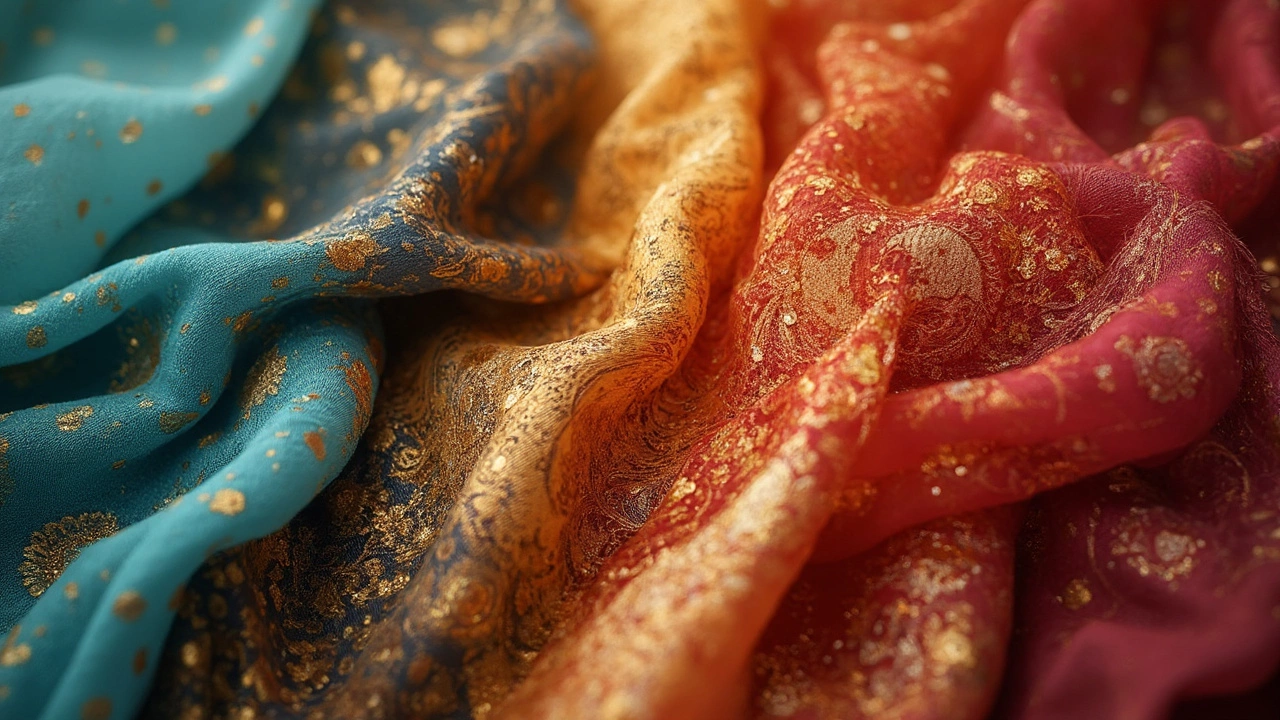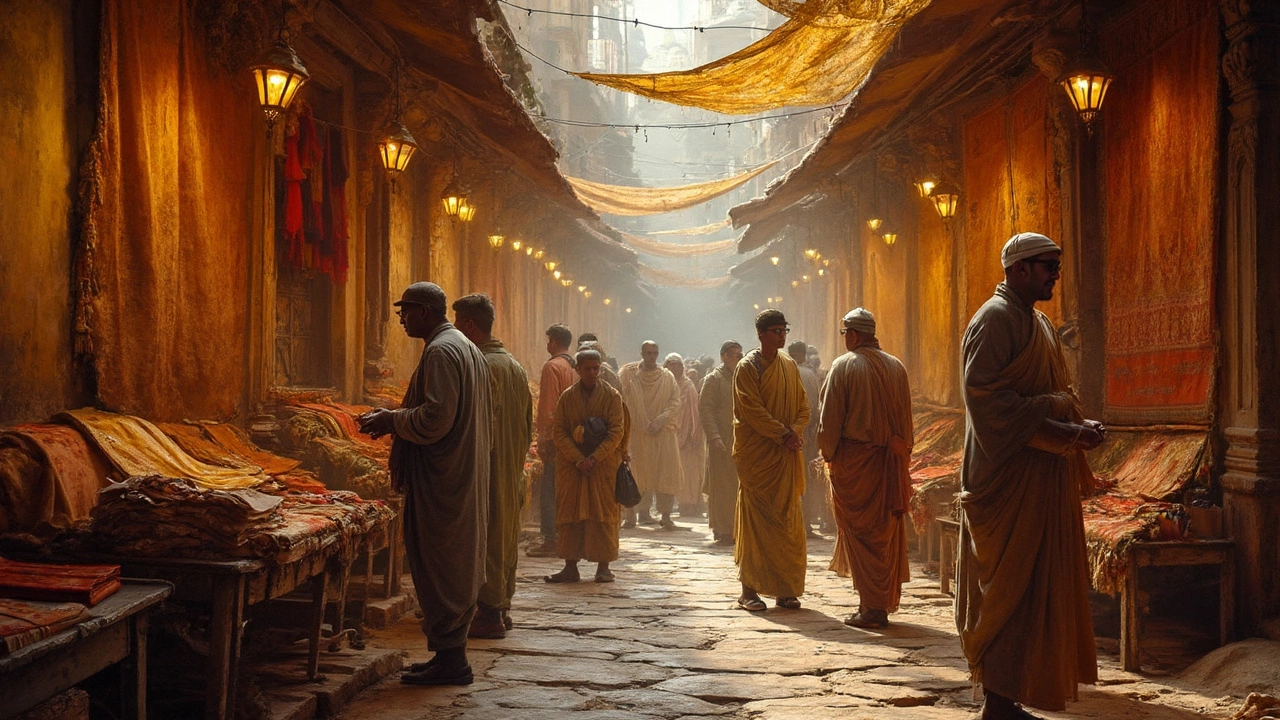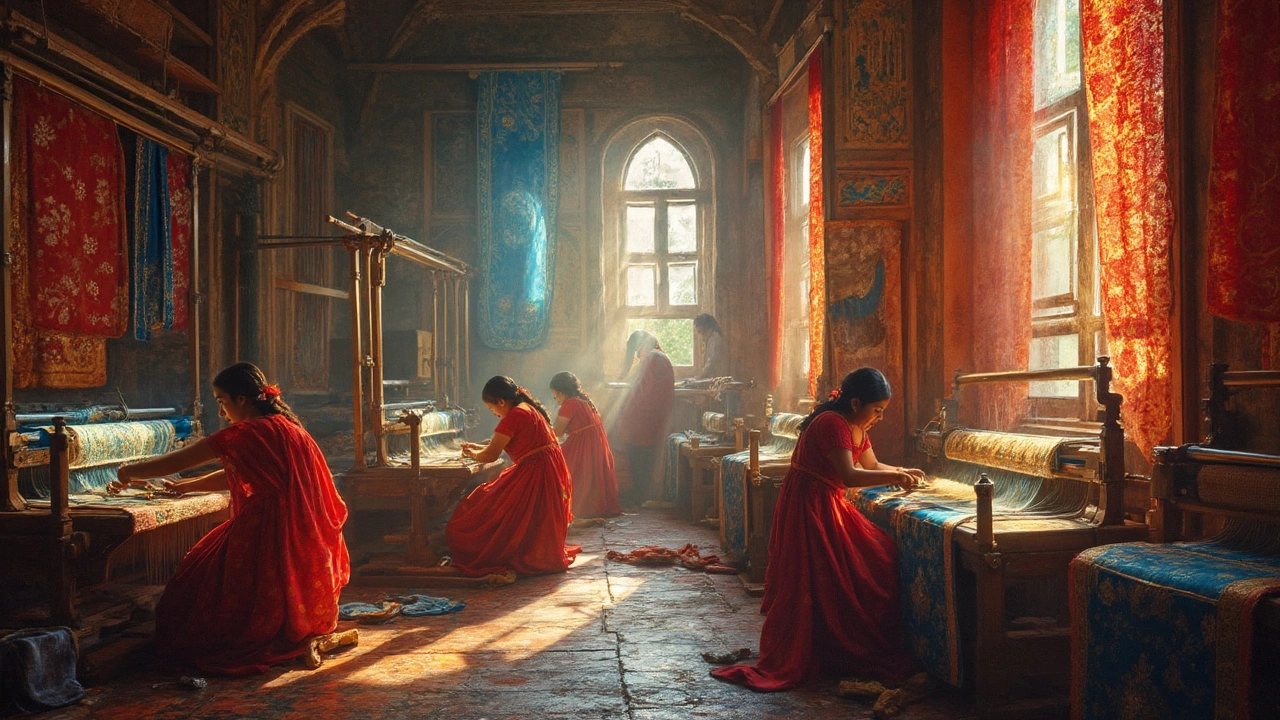Ever got sticker shock while shopping for fabric in India? Trust me, you’re not alone. Some textiles here can cost more than your monthly rent. The big question is—what exactly makes these fabrics so expensive? Is it the rare material, the hours that go into weaving, or something else?
Let's get real. In India, everything from simple cotton to jaw-dropping silk is out there. But when it comes to price tags, it’s the silk sarees, pure pashmina shawls, and handwoven masterpieces that often leave buyers scratching their heads or pulling out their credit cards. Why are people willing to pay up to lakhs (yep, lakhs) for a few meters of cloth?
If you’re planning to buy high-end fabric, or just curious about why some sarees are locked behind glass cases, you’ve come to the right place. You’ll get the lowdown on what pushes the cost up, which fabrics top the charts, and what to look for if you want your money’s worth.
- Why Some Fabrics Cost a Fortune
- The Silk Story: India’s Luxury Threads
- Handloom Wonders: Banarasi, Kanjeevaram, and More
- Regional Hotspots for Expensive Fabrics
- Buying Tips and How to Spot Value
Why Some Fabrics Cost a Fortune
So, why are some pieces of fabric in India priced like luxury items? First, it comes down to a few big reasons—material, labor, tradition, and sometimes, even the brand or location it’s from. It’s more than just what you touch. It’s about effort, heritage, and scarcity.
The material itself makes a huge difference. Top-grade mulberry silk, genuine pashmina from Kashmir goats, and pure zari (that’s gold or silver thread) don’t come cheap. It’s not just the raw stuff, though. Making these into fabric takes serious skill and time.
- Expensive fabrics India often rely on manual weaving. Weavers can spend weeks or even months crafting a single saree—think Banarasi or Kanjeevaram silk.
- If the design is complicated and packed with detail, expect the price to shoot up. Hand-embroidered fabrics or ones with intricate borders can cost several times more than plain versions.
- Real metal threads (zari) matter. Fake ones bring down costs, but authentic gold or silver borders will make the price feel like a punch.
- Limited editions or rare regional techniques, like Patola double ikat from Gujarat, are naturally pricey because very few artisans master the craft.
Check out how much more you might pay for high-end materials versus everyday options:
| Fabric Type | Approx. Price Range (per meter) |
|---|---|
| Banarasi Silk | ₹2,000 – ₹15,000+ |
| Kanjeevaram Silk | ₹3,000 – ₹25,000+ |
| Pure Pashmina | ₹5,000 – ₹40,000+ |
| Handloom Cotton | ₹200 – ₹1,500 |
| Machine-Made Polyester | ₹50 – ₹300 |
Labor is a big chunk of the price. In some craft clusters, families have been weaving for generations, and even training takes years. That’s why those authentic Banarasi or Kanjeevaram sarees cost more—they carry that legacy and detail you just won’t get from a machine.
So next time you see a steep price tag, look closer. It’s not just fabric you’re paying for—it’s the skill, the tradition, and sometimes, even a tiny piece of history.
The Silk Story: India’s Luxury Threads
Step into any big Indian wedding, and you’ll see silk stealing the show. But why does silk command such crazy prices in India? It’s all about tradition, difficulty, and demand.
Silk weaving runs deep in the Indian culture, with evidence going back thousands of years. Even today, India is the world’s second-largest silk producer after China. That said, India outshines the rest when it comes to high-end, artisanal silk sarees. Walk into a store in Kanjeevaram or Varanasi, and some sarees cost upwards of ₹2 lakh (about $2,400) each.
What pushes up the price so much? Here’s the breakdown:
- Raw Silk Quality: Most top-tier Indian silks use pure mulberry silk, which is the priciest type. No mixing in synthetic threads here.
- Intensive Labour: Real handloom silk sarees take days—sometimes months—to make. Each zari pattern or motif is hand-crafted.
- Gold and Silver Zari: Some sarees are woven with real silver threads coated with gold. The cost of these metals only goes up.
If you wonder just how far this can go, check out this stat table:
| Type of Silk Saree | Average Price (INR) | Production Time | Main Region |
|---|---|---|---|
| Kanjeevaram | 50,000 – 300,000 | 15–30 days | Tamil Nadu |
| Banarasi | 20,000 – 250,000 | 10–45 days | Uttar Pradesh |
| Patola | 100,000 – 500,000 | 45–90 days | Gujarat |
Here’s how an actual silk dealer in Varanasi puts it:
“Silk is more than a fabric; it’s a mark of tradition and pride. Skilled artisans spend weeks on a single saree, and families treasure them for generations.”
If you’re looking to buy, look for a Silk Mark tag. It means the silk is pure and certified. Avoid deals that sound too good to be true—those are usually blended or machine-made. For the real deal, you’ll shell out more, but it’ll last much longer and possibly become a family heirloom. That’s what makes silk India’s trademark expensive fabric.
So next time someone complains about the price, you know—you’re buying more than cloth; you’re buying skill, time, and centuries of tradition. That’s the real cost behind luxury Indian silk.

Handloom Wonders: Banarasi, Kanjeevaram, and More
If you ask anyone in India about expensive fabrics, Banarasi and Kanjeevaram sarees are probably the first names you’ll hear. These aren’t just your average textiles. We're talking about fabric that can turn heads at a wedding and sometimes double up as family heirlooms. The sad reality: fakes are everywhere, but true handlooms are tough to copy and demand respect (and big bucks).
Let’s get specific. Banarasi sarees come from Varanasi. Weavers here use pure silk yarn, gold and silver threads—sometimes actual zari, not the cheap polyester stuff. You’ll notice true Banarasi sarees have high thread counts and weighty feel because of the rich work. Depending on the pattern and material, these can set you back anywhere from ₹15,000 to over ₹3,00,000. Weird fact: some Banarasi sarees take up to six months to make. Yes, half a year for one saree. That’s serious labor.
Kanjeevaram sarees are the pride of Tamil Nadu. The silk is thick, the motifs are loud, and the borders contrast so well, you spot them from a mile away. Genuine Kanjeevarams are made with mulberry silk and real zari, making them strong enough to last generations. They usually start at ₹10,000 and collector’s pieces can cost north of ₹2,00,000 each.
But wait, there’s more than just Banarasi and Kanjeevaram. Here are a few others that hit luxury status:
- Patola (Gujarat): Double ikat technique. Patterns show up the same front and back. Takes months of planning and dyeing.
- Chanderi (Madhya Pradesh): Lightweight, see-through silk-cotton blends with traditional motifs. Loved for summer weddings.
- Paithani (Maharashtra): Super colorful silk with peacock and flower patterns. Tangled in tradition, takes ages to weave.
Want to see how much these can cost? Here’s what you usually pay if you’re buying the real deal:
| Fabric Name | Main Region | Average Price (INR) | Production Time |
|---|---|---|---|
| Banarasi | Varanasi, UP | ₹15,000 - ₹3,00,000+ | 1-6 months |
| Kanjeevaram | Kanchipuram, TN | ₹10,000 - ₹2,00,000+ | 15 days - 3 months |
| Patola | Patan, Gujarat | ₹50,000 - ₹3,50,000 | 3-12 months |
| Chanderi | Chanderi, MP | ₹5,000 - ₹80,000 | 2-30 days |
| Paithani | Yeola, Maharashtra | ₹25,000 - ₹2,50,000 | 1-12 months |
Thinking of buying? Stick to authorized shops or government handloom outlets if you want the real thing. And always ask if you can see the GI tag (Geographical Indication mark)—it’s a badge of authenticity for India’s top textiles. Nobody wants to spend lakhs on a fake, trust me.
Regional Hotspots for Expensive Fabrics
When it comes to sky-high fabric prices, where the cloth comes from matters as much as what it’s made of. India has a few cities and regions that are basically legends in the world of expensive fabrics India.
If you ever set foot in Varanasi, you’ll see why Banarasi silk is so hyped. Each saree is packed with zari (gold or silver thread) and takes about 15 to 20 days—sometimes even months—to weave. These craftsmen use skills that have been passed down in families for centuries. That’s a whole heritage stitched into every piece, and it’s a big reason you see prices hitting ₹1 lakh or more for one of these sarees.
Head south and you’ll hit Kanchipuram in Tamil Nadu. The silk here is thicker and rich, which is why Kanjeevaram sarees look and feel expensive. The secret? Pure mulberry silk and real silver zari. This combo makes them durable as well as classy.
Now, if you ever get to Srinagar, don’t miss the Kashmiri Pashmina shawls. Real pashmina comes from a special kind of goat found only in Ladakh, and each shawl is hand-spun and woven. We’re talking tiny supply and massive demand, which pumps up the price—some go upwards of ₹70,000 a piece!
Gujarat has its own gem too: Patola from Patan. Making one Patola saree can take about a year. Yes, a whole year for a single saree. That’s because of a madly detailed double ikat technique. Production is super limited—just a few families even know how it’s done.
Here’s a quick look at where some of the most expensive Indian fabrics come from and what makes each place unique:
| Region/City | Famous Fabric | Main Features | Average High Price (₹) |
|---|---|---|---|
| Varanasi | Banarasi Silk | Zari work, intricate brocade, time-consuming handloom | 1,00,000+ |
| Kanchipuram | Kanjeevaram Silk | Pure mulberry silk, silver zari, thick weave | 75,000+ |
| Srinagar | Pashmina Shawl | Hand-spun pashmina wool, rare goats | 70,000+ |
| Patan | Patola | Double ikat, takes months or even a year | 1,50,000+ |
If you’re eyeing something that screams luxury and tradition, these hotspots are pretty much the gold standard. But a quick tip: Always check if you’re getting the real deal. Fake Banarasi or machine-made pashmina is everywhere these days, so it pays to buy from trusted shops or directly from artisans.

Buying Tips and How to Spot Value
Walking into a fabric store or a high-end boutique, you might wonder if you're paying for the real deal or just getting caught up in the hype. Nobody wants to blow their money on something fake. Here’s how you can make smarter choices when hunting for expensive Indian fabrics.
- expensive fabrics India usually come with certificates of authenticity, especially if you’re looking at something like handwoven Banarasi silk or pure pashmina. Always ask for these documents if available.
- Feel the texture. Pure silk feels soft, but there's a slight roughness if you rub it between your fingers, while artificial silk is too smooth. With pashmina, the warmth and fineness are instantly obvious. If you’re not sure, burn a tiny thread—real silk smells like burnt hair, but synthetic melts and smells weird.
- Check the selvedge (the finished edge of the fabric). Handloom products like Kanjeevaram sarees have small uneven threads on the selvedge, a marker that a machine didn’t make it.
- Be wary of too-good-to-be-true prices. If a store says a pure Banarasi saree is under ₹2000, it’s probably not pure. Real ones easily start around ₹7,000 to ₹10,000 and can go much higher.
- Shop from government-run stores or trusted sellers that specialize in heritage textiles—places like Khadi India, Central Cottage Industries Emporium, or well-known outlets in cities like Varanasi or Kanchipuram. These places are less likely to pass off imitations.
If you’re buying online, look for detailed product descriptions and zoom in on fabric photos. Ask questions if the seller is unsure about the origin or weave. Search for buyer reviews—they can be eye-opening.
And don’t forget, care instructions matter. Expensive fabrics often need dry cleaning or gentle hand wash. Skimping on care can ruin them fast, and that's money down the drain. If you’re investing, learn how to store and maintain your fabric. Store silks in cool, dry places wrapped in cotton, and fold pashmina shawls with tissue paper.
Spotting real value is all about knowing the markers of true craft and not getting sold on just a pretty price tag. It takes just a little homework, but your wardrobe (and bank account) will thank you.
